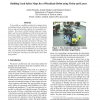Free Online Productivity Tools
i2Speak
i2Symbol
i2OCR
iTex2Img
iWeb2Print
iWeb2Shot
i2Type
iPdf2Split
iPdf2Merge
i2Bopomofo
i2Arabic
i2Style
i2Image
i2PDF
iLatex2Rtf
Sci2ools
CRV
2006
IEEE
2006
IEEE
Building Local Safety Maps for a Wheelchair Robot using Vision and Lasers
To be useful as a mobility assistant for a human driver, an intelligent robotic wheelchair must be able to distinguish between safe and hazardous regions in its immediate environment. We present a hybrid method using laser rangefinders and vision for building local 2D metrical maps that incorporate safety information (called local safety maps). Laser range-finders are used for localization and mapping of obstacles in the 2D laser plane, and vision is used for detection of hazards and other obstacles in 3D space. The hazards and obstacles identified by vision are projected into the travel plane of the robot and combined with the laser map to construct the local 2D safety map. The main contributions of this work are (i) the definition of a local 2D safety map, (ii) a hybrid method for building the safety map, and (iii) a method for removing noise from dense stereo data using motion.
CRV 2006 | Hybrid Method | Local 2D Safety | Robotics | Safety Map |
| Added | 20 Aug 2010 |
| Updated | 20 Aug 2010 |
| Type | Conference |
| Year | 2006 |
| Where | CRV |
| Authors | Aniket Murarka, Joseph Modayil, Benjamin Kuipers |
Comments (0)

